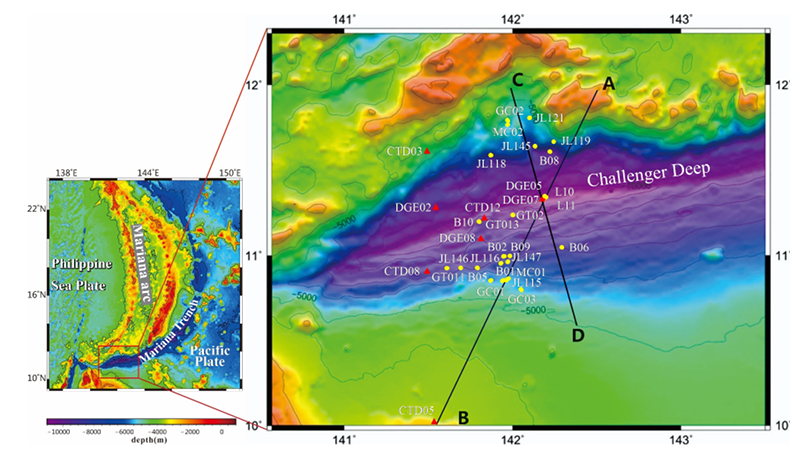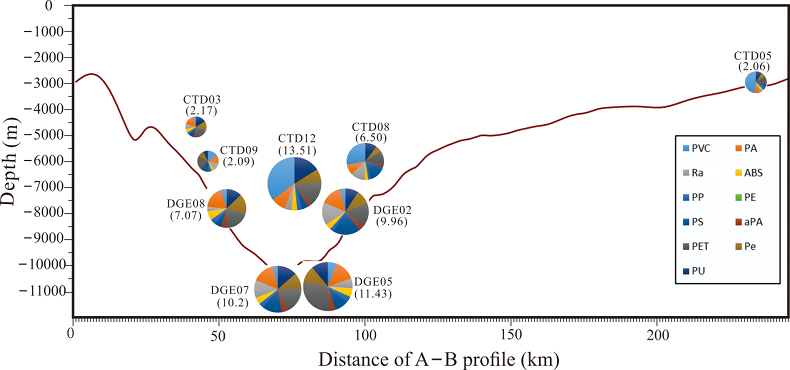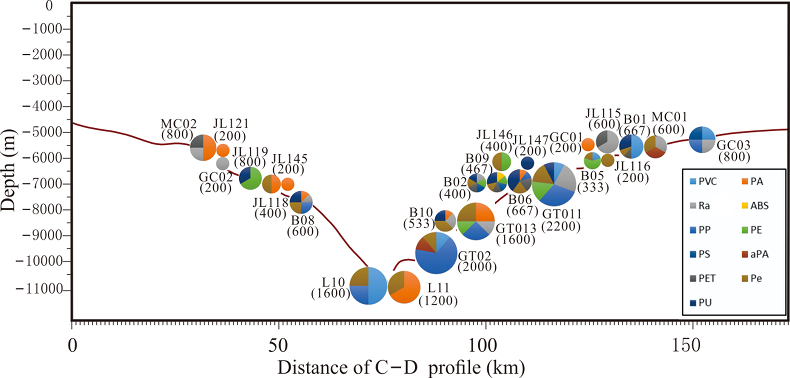Microplastics contaminate the deepest part of the world’s ocean
Affiliations | Corresponding Author | Cite as | Funding information- Share this article





Article views:24,009 - in the top 10Cumulative count of HTML views and PDF downloads.
- Download Citation
- Rights & Permissions
top
Abstract

Figures and Tables
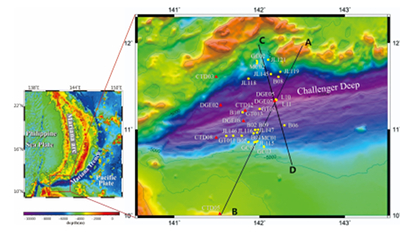 Figure 1 Sampling location map of Mariana Trench seawater (in red triangles) and sediments (in yellow circles). Please see Tables S-1 and S-2 for sampling details. | 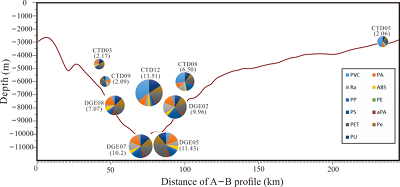 Figure 2 Profile of microplastic abundances and compositions in water samples from Mariana Trench. Pie charts represent the microplastic compositions and numbers in the bracket are the microplastic abundances with units of pieces per litre. PVC-polyvinyl chloride, PA-polyamide, Ra-rayon, ABS-acrylonitrile butadiene styrene, PP-polypropylene, PE-polyethylene, PS-polystyrene, aPA-aromatic polyamide, PET-polyethylene terephthalate, Pe-polyester, PU-polyurethane. The X-axis corresponds to the crossline from point A (12 ºN, 142.5 ºE) to point B (9.8 ºN, 141.43 ºE) in Figure 1. | 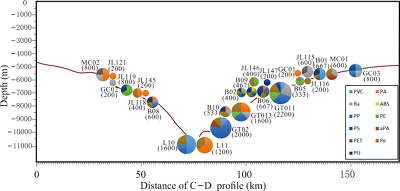 Figure 3 Profile of microplastic abundances and compositions in sediment samples from Mariana Trench. Pie charts represent the microplastic compositions and numbers in the bracket are the microplastic abundances with units of pieces per litre. PVC-polyvinyl chloride, PA-polyamide, Ra-rayon, ABS-acrylonitrile butadiene styrene, PP-polypropylene, PE-polyethylene, PS-polystyrene, aPA-aromatic polyamide, PET-polyethylene terephthalate, Pe-polyester, PU-polyurethane. The X-axis corresponds to the crossline from point C (12 ºN, 141.9 ºE) to point D (10.5 ºN, 141.3 ºE) in Figure 1. |  Table 1 Abundance of microplastics in seawater and sediments in open oceans worldwide. |
| Figure 1 | Figure 2 | Figure 3 | Table 1 |
top
Letter
Plastics are worldwide marine pollutants, accumulating in seawater and sediments (Hammer et al., 2012
Hammer, J., Kraak, M.H.S., Parsons, J.R. (2012) Plastics in the marine environment: the dark side of a modern gift. In: Whitacre, D. (Ed.) Reviews of Environmental Contamination and Toxicology. Reviews of Environmental Contamination and Toxicology (Continuation of Residue Reviews), volume 220. Springer, New York, 1-44.
; Cózar et al., 2014Cózar, A., Echevarría, F., González-Gordillo, J.I., Irigoien, X., Úbeda, B., Hernández-León, S., Palma, A.T., Navarro, S., García-de-Lomas, J., Ruiz, A., Fernández-de-Puelles, M.L., Duarte, C.M. (2014) Plastic debris in the open ocean. Proceedings of the National Academy of Sciences 111, 10239-10244.
; Ivar do Sul and Costa, 2014Ivar do Sul, J.A., Costa, M.F. (2014) The present and future of microplastic pollution in the marine environment. Environmental Pollution 185, 352-364.
). It was estimated that between 4.8 and 12.7 million metric tons of plastic waste entered the ocean in 2010 and this mass could increase by one order of magnitude by 2025 (Jambeck et al., 2015Jambeck, J.R., Geyer, R., Wilcox, C., Siegler, T.R., Perryman, M., Andrady, A., Narayan, R., Law, K.L. (2015) Plastic waste inputs from land into the ocean. Science 347, 768-771.
; Geyer et al., 2017Geyer, R., Jambeck, J.R., Law, K.L. (2017) Production, use, and fate of all plastics ever made. Science Advances 3, doi: 10.1126/sciadv.1700782.
). Besides the ocean surface (Thompson et al., 2004Thompson, R.C., Olsen, Y., Mitchell, R.P., Davis, A., Rowland, S.J., John, A.W., Russell, A.E. (2004) Lost at sea: where is all the plastic? Science 304, 838-838.
; Barnes et al., 2009Barnes, D.K., Galgani, F., Thompson, R.C., Barlaz, M. (2009) Accumulation and fragmentation of plastic debris in global environments. Philosophical Transactions of the Royal Society B: Biological Sciences 364, 1985-1998.
; Van Sebille et al., 2015Van Sebille, E., Wilcox, C., Lebreton, L., Maximenko, N., Hardesty, B.D., Van Franeker, J.A., Eriksen, M., Siegel, D., Galgani, F., Law, K.L. (2015) A global inventory of small floating plastic debris. Environmental Research Letters 10, doi: 10.1088/1748-9326/10/12/124006.
; Chae and An, 2017Chae, Y., An, Y.J. (2017) Effects of micro-and nanoplastics on aquatic ecosystems: Current research trends and perspectives. Marine Pollution Bulletin 124, 624-632.
), potential sinks for plastics include deep sea biota (Oliveira et al., 2012Oliveira, M., Ribeiro, A., Guilhermino, L. (2012) Effects of exposure to microplastics and PAHs on microalgae Rhodomonas baltica and Tetraselmis chuii. Comparative Biochemistry and Physiology Part A, S19-S20.
), the water column (Courtene-Jones et al., 2017Courtene-Jones, W., Quinn, B., Gary, S.F., Mogg, A.O., Narayanaswamy, B.E. (2017) Microplastic pollution identified in deep-sea water and ingested by benthic invertebrates in the Rockall Trough, North Atlantic Ocean. Environmental Pollution 231, 271-280.
; Kanhai et al., 2018Kanhai, L.D.K., Gårdfeldt, K., Lyashevska, O., Hassellöv, M., Thompson, R.C., O'Connor, I. (2018) Microplastics in sub-surface waters of the Arctic Central Basin. Marine Pollution Bulletin 130, 8-18.
) and sediments (Bergmann et al., 2017Bergmann, M., Wirzberger, V., Krumpen, T., Lorenz, C., Primpke, S., Tekman, M.B., Gerdts, G. (2017) High Quantities of Microplastic in Arctic Deep-Sea Sediments from the HAUSGARTEN Observatory. Environmental Science & Technology 51, 11000-11010.
), where broken plastics exist as microplastics (<5 mm in size) (Arthur et al., 2009Arthur, C., Baker, J., Bamford, H. (Eds.) (2009) Proceedings of the International Research Workshop on the Occurrence, Effects and Fate of Microplastic Marine Debris. Sept. 9-11, 2008. NOAA Technical Memorandum NOS-OR&R-30.
; Hidalgo-Ruz et al., 2012Hidalgo-Ruz, V., Gutow, L., Thompson, R.C., Thiel, M. (2012) Microplastics in the marine environment: a review of the methods used for identification and quantification. Environmental Science & Technology 46, 3060-3075.
). So far, however, microplastics in the deepest ocean remain largely unexplored.The hadal zone, which is the deepest region (6000-11000 m) of the oceans lying within trenches, represents 1-2 % of the global benthic area (Jamieson et al., 2010
Jamieson, A.J., Fujii, T., Mayor, D.J., Solan, M., Priede, I.G. (2010) Hadal trenches: the ecology of the deepest places on Earth. Trends in Ecology & Evolution 25, 190-197.
). Although it was reported that toxic anthropogenic pollutants (e.g., persistent organic pollutants) have reached the deepest ocean on Earth (Jamieson et al., 2017Jamieson, A.J., Malkocs, T., Piertney, S.B., Fujii, T., Zhang, Z. (2017) Bioaccumulation of persistent organic pollutants in the deepest ocean fauna. Nature Ecology & Evolution 1, doi: 10.1038/s41559-016-0051.
; Dasgupta et al., 2018Dasgupta, S., Peng, X., Chen, S., Li, J., Du, M., Zhou, Y.-H., Zhong, G., Xu, H., Ta, K. (2018) Toxic anthropogenic pollutants reach the deepest ocean on Earth. Geochemical Perspectives Letters 7, 22-26.
), little is known about the nature of anthropogenic microplastics in this deep and remote environment. To evaluate the abundance, distribution, and fate of microplastics in the hadal zone, we collected bottom water samples and sediment samples at depths of 2500-11000 m and 5500-11000 m, respectively, from the southern Mariana Trench, where the Challenger Deep, the deepest point on Earth, is situated (Fujioka et al., 2002Fujioka, K., Okino, K., Kanamatsu, T., Ohara, Y. (2002) Morphology and origin of the Challenger Deep in the Southern Mariana Trench. Geophysical Research Letters 29, doi: 10.1029/2001GL013595.
) (Fig. 1).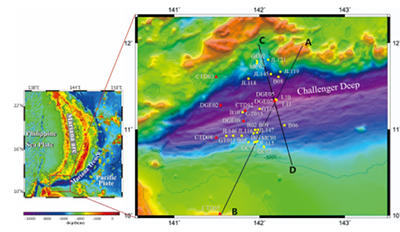
Figure 1 Sampling location map of Mariana Trench seawater (in red triangles) and sediments (in yellow circles). Please see Tables S-1 and S-2 for sampling details.
Identification by optical microscope and Raman spectrometer confirmed that microplastics are abundant in hadal bottom water (Fig. S-1). The microplastics are fibrous, rod-like, and roundish in shape, and mostly blue, red, white, green, and purple in colour. Plastic microfibres dominate in all the microplastics and are commonly 1-3 mm in length in seawater samples and mostly 0.1-0.5 mm in sediment samples (Table S-4). The microplastic abundances in bottom waters range from 2.06 to 13.51 pieces per litre and become more concentrated with depth (Fig. 2) with one exception at depth of 6802 m, reaching 13.51 pieces per litre. At 10903 m, the microplastic abundance reaches 11.43 pieces per litre, which is four times higher than that reported in the subsurface water of open seas, including the NE Pacific Ocean (Desforges et al., 2014
Desforges, J.P.W., Galbraith, M., Dangerfield, N., Ross, P.S. (2014) Widespread distribution of microplastics in subsurface seawater in the NE Pacific Ocean. Marine Pollution Bulletin 79, 94-99.
), South Pacific subtropical gyre (Eriksen et al., 2013Eriksen, M., Maximenko, N., Thiel, M., Cummins, A., Lattin, G., Wilson, S., Rifman, S. (2013) Plastic pollution in the South Pacific subtropical gyre. Marine Pollution Bulletin 68, 71-76.
), North Pacific Gyre (Goldstein, 2012Goldstein, M.C. (2012) Abundance and ecological implications of microplastic debris in the North Pacific Subtropical Gyre. Doctoral dissertation, University of California, San Diego.
), North Atlantic Ocean (Courtene-Jones et al., 2017Courtene-Jones, W., Quinn, B., Gary, S.F., Mogg, A.O., Narayanaswamy, B.E. (2017) Microplastic pollution identified in deep-sea water and ingested by benthic invertebrates in the Rockall Trough, North Atlantic Ocean. Environmental Pollution 231, 271-280.
), and the Arctic Ocean (Bergmann et al., 2017Bergmann, M., Wirzberger, V., Krumpen, T., Lorenz, C., Primpke, S., Tekman, M.B., Gerdts, G. (2017) High Quantities of Microplastic in Arctic Deep-Sea Sediments from the HAUSGARTEN Observatory. Environmental Science & Technology 51, 11000-11010.
; Kanhai et al., 2018Kanhai, L.D.K., Gårdfeldt, K., Lyashevska, O., Hassellöv, M., Thompson, R.C., O'Connor, I. (2018) Microplastics in sub-surface waters of the Arctic Central Basin. Marine Pollution Bulletin 130, 8-18.
) (Table 1). The high abundance of microplastics in hadal bottom water is also comparable to that reported in coastal waters, for example, in the Yangtze River and the Strait of Georgia, which are regarded as heavily polluted by microplastics (Desforges et al., 2014Desforges, J.P.W., Galbraith, M., Dangerfield, N., Ross, P.S. (2014) Widespread distribution of microplastics in subsurface seawater in the NE Pacific Ocean. Marine Pollution Bulletin 79, 94-99.
; Zhao et al., 2014Zhao, S., Zhu, L., Wang, T., Li, D. (2014) Suspended microplastics in the surface water of the Yangtze Estuary System, China: first observations on occurrence, distribution. Marine Pollution Bulletin 86, 562-568.
).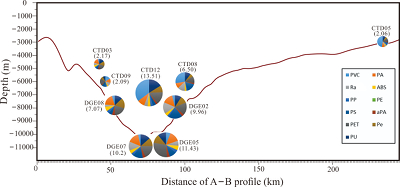
Figure 2 Profile of microplastic abundances and compositions in water samples from Mariana Trench. Pie charts represent the microplastic compositions and numbers in the bracket are the microplastic abundances with units of pieces per litre. PVC-polyvinyl chloride, PA-polyamide, Ra-rayon, ABS-acrylonitrile butadiene styrene, PP-polypropylene, PE-polyethylene, PS-polystyrene, aPA-aromatic polyamide, PET-polyethylene terephthalate, Pe-polyester, PU-polyurethane. The X-axis corresponds to the crossline from point A (12 ºN, 142.5 ºE) to point B (9.8 ºN, 141.43 ºE) in Figure 1.
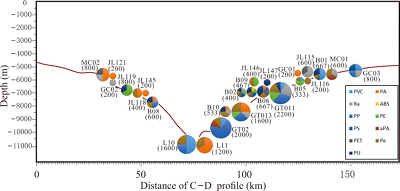
Figure 3 Profile of microplastic abundances and compositions in sediment samples from Mariana Trench. Pie charts represent the microplastic compositions and numbers in the bracket are the microplastic abundances with units of pieces per litre. PVC-polyvinyl chloride, PA-polyamide, Ra-rayon, ABS-acrylonitrile butadiene styrene, PP-polypropylene, PE-polyethylene, PS-polystyrene, aPA-aromatic polyamide, PET-polyethylene terephthalate, Pe-polyester, PU-polyurethane. The X-axis corresponds to the crossline from point C (12 ºN, 141.9 ºE) to point D (10.5 ºN, 141.3 ºE) in Figure 1.
Table 1 Abundance of microplastics in seawater and sediments in open oceans worldwide.
| Sample type | Depth (m) | p(pieces)/L | Study area | References |
| seawater | 2673-10908 | 2.06-13.51 | Mariana Trench | This study |
| seawater | 4.5 | 3.20+0.60 | Strait of Georgia | Desforges et al. (2014) Desforges, J.P.W., Galbraith, M., Dangerfield, N., Ross, P.S. (2014) Widespread distribution of microplastics in subsurface seawater in the NE Pacific Ocean. Marine Pollution Bulletin 79, 94-99. |
| seawater | 1 | 4.14+2.46 | Yangtze estuary | Zhao et al. (2014) Zhao, S., Zhu, L., Wang, T., Li, D. (2014) Suspended microplastics in the surface water of the Yangtze Estuary System, China: first observations on occurrence, distribution. Marine Pollution Bulletin 86, 562-568. |
| seawater | 1 | 0.02 (p/m2) | South Pacific subtropical gyre | Eriksen et al. (2013) Eriksen, M., Maximenko, N., Thiel, M., Cummins, A., Lattin, G., Wilson, S., Rifman, S. (2013) Plastic pollution in the South Pacific subtropical gyre. Marine Pollution Bulletin 68, 71-76. |
| seawater | 4.5 | 0.28+0.18 | NE Pacific Ocean | Desforges et al. (2014) Desforges, J.P.W., Galbraith, M., Dangerfield, N., Ross, P.S. (2014) Widespread distribution of microplastics in subsurface seawater in the NE Pacific Ocean. Marine Pollution Bulletin 79, 94-99. |
| seawater | 2227 | 0.07 | Rockall Trough | Courtene-Jones et al. (2017) Courtene-Jones, W., Quinn, B., Gary, S.F., Mogg, A.O., Narayanaswamy, B.E. (2017) Microplastic pollution identified in deep-sea water and ingested by benthic invertebrates in the Rockall Trough, North Atlantic Ocean. Environmental Pollution 231, 271-280. |
| seawater | 50-4369 | 0.02-0.38 | Arctic Central Basin | Kanhai et al. (2018) Kanhai, L.D.K., Gårdfeldt, K., Lyashevska, O., Hassellöv, M., Thompson, R.C., O'Connor, I. (2018) Microplastics in sub-surface waters of the Arctic Central Basin. Marine Pollution Bulletin 130, 8-18. |
| sediment | 5108-10908 | 200-2200 (0.27-6.20 p/g) | Mariana Trench | This study |
| sediment | 2783-5570 | 44-3463.71 (0.04-6.59 p/g) | HAUSGARTEN observatory in the Arctic | Bergmann et al. (2017) Bergmann, M., Wirzberger, V., Krumpen, T., Lorenz, C., Primpke, S., Tekman, M.B., Gerdts, G. (2017) High Quantities of Microplastic in Arctic Deep-Sea Sediments from the HAUSGARTEN Observatory. Environmental Science & Technology 51, 11000-11010. |
| sediment | 900-1000 | 28-80 | SW Indian Ocean | Woodall et al. (2014) Woodall, L.C., Sanchez-Vidal, A., Canals, M., Paterson, G.L., Coppock, R., Sleight, V., Calafat, A., Rogers, D.A., Narayanaswamy, E.B., Thompson, R.C. (2014) The deep sea is a major sink for microplastic debris. Royal Society Open Science 1, doi: 10.1098/rsos.140317. |
| sediment | 1400-2200 | 120-800 | NE Atlantic | Woodall et al. (2014) Woodall, L.C., Sanchez-Vidal, A., Canals, M., Paterson, G.L., Coppock, R., Sleight, V., Calafat, A., Rogers, D.A., Narayanaswamy, E.B., Thompson, R.C. (2014) The deep sea is a major sink for microplastic debris. Royal Society Open Science 1, doi: 10.1098/rsos.140317. |
| sediment | 300-1300 | 200-700 | Mediterranean | Woodall et al. (2014) Woodall, L.C., Sanchez-Vidal, A., Canals, M., Paterson, G.L., Coppock, R., Sleight, V., Calafat, A., Rogers, D.A., Narayanaswamy, E.B., Thompson, R.C. (2014) The deep sea is a major sink for microplastic debris. Royal Society Open Science 1, doi: 10.1098/rsos.140317. |
| sediment | 2419-4881 | 0-40 | Polar front of the Southern Ocean | Van Cauwenberghe et al. (2013) Van Cauwenberghe, L., Vanreusel, A., Mees, J., Janssen, C.R. (2013) Microplastic pollution in deep-sea sediments. Environment Pollution 182, 495-499. |
The colourful microplastics were also widely identified in hadal sediments (Fig. 3). Like the bottom water, microfibres were abundant in the sediments (Table S-4). Microplastic abundances in hadal sediments ranged from 200 to 2200 pieces per litre. Higher abundances were commonly found in deeper hadal sediments, especially at depths of 7000-11000 m. The maximum value reached 2200 pieces per litre at the depth of 7180 m, followed by 2000 pieces per litre at 9373 m. We compared the microplastic abundances of our sediment samples with that in deep sea sediments reported from other studies (Van Cauwenberghe et al., 2013
Van Cauwenberghe, L., Vanreusel, A., Mees, J., Janssen, C.R. (2013) Microplastic pollution in deep-sea sediments. Environment Pollution 182, 495-499.
; Woodall et al., 2014Woodall, L.C., Sanchez-Vidal, A., Canals, M., Paterson, G.L., Coppock, R., Sleight, V., Calafat, A., Rogers, D.A., Narayanaswamy, E.B., Thompson, R.C. (2014) The deep sea is a major sink for microplastic debris. Royal Society Open Science 1, doi: 10.1098/rsos.140317.
; Bergmann et al., 2017Bergmann, M., Wirzberger, V., Krumpen, T., Lorenz, C., Primpke, S., Tekman, M.B., Gerdts, G. (2017) High Quantities of Microplastic in Arctic Deep-Sea Sediments from the HAUSGARTEN Observatory. Environmental Science & Technology 51, 11000-11010.
) (Table 1). The maximum abundance of microplastics detected in the Mariana sediments is twice as high as that reported in deep sea sediments from the Atlantic Ocean and the Mediterranean Sea (70-800 pieces per litre, Woodall et al., 2014Woodall, L.C., Sanchez-Vidal, A., Canals, M., Paterson, G.L., Coppock, R., Sleight, V., Calafat, A., Rogers, D.A., Narayanaswamy, E.B., Thompson, R.C. (2014) The deep sea is a major sink for microplastic debris. Royal Society Open Science 1, doi: 10.1098/rsos.140317.
), and twenty times more than that in deep sea sediments from the SW Indian Ocean and the Southern Atlantic (Van Cauwenberghe et al., 2013Van Cauwenberghe, L., Vanreusel, A., Mees, J., Janssen, C.R. (2013) Microplastic pollution in deep-sea sediments. Environment Pollution 182, 495-499.
; Woodall et al., 2014Woodall, L.C., Sanchez-Vidal, A., Canals, M., Paterson, G.L., Coppock, R., Sleight, V., Calafat, A., Rogers, D.A., Narayanaswamy, E.B., Thompson, R.C. (2014) The deep sea is a major sink for microplastic debris. Royal Society Open Science 1, doi: 10.1098/rsos.140317.
). However, it is comparable to Arctic deep sea sediments, where the highest abundance of microplastics recorded was 3463.71 pieces per litre, at a depth of 2783 m (Bergmann et al., 2017Bergmann, M., Wirzberger, V., Krumpen, T., Lorenz, C., Primpke, S., Tekman, M.B., Gerdts, G. (2017) High Quantities of Microplastic in Arctic Deep-Sea Sediments from the HAUSGARTEN Observatory. Environmental Science & Technology 51, 11000-11010.
).Eleven different polymers, including polyvinyl chloride, polyamide, rayon, acrylonitrile butadiene styrene, polypropylene, polyethylene, polystyrene, aromatic polyamide, polyethylene terephthalate, polyester, and polyurethane were identified from the Mariana samples (Fig. 2). Polyethylene terephthalate accounted for the largest proportion (19 %) in hadal bottom waters, followed by polyamide (14 %), polyvinyl chloride (13 %), polyurethane (12 %), polyester (11 %), polystyrene (11 %), and rayon (9 %) (Fig. 2). In the sediments, polyester accounted for the largest proportion (19 %), followed by polypropylene (15 %), polyurethane (14 %), polyamide (12 %), polyamide (12 %), polyvinyl chloride (10 %), rayon (10 %), and polyethylene (9 %) (Fig. 3). Microplastic compositions from our study are different from those previously reported in other deep sea environments. For example, polypropylene and polyethylene are most abundant in the water column of the North Pacific Ocean (Rios et al., 2007
Rios, L.M., Moore, C., Jones, P.R. (2007) Persistent organic pollutants carried by synthetic polymers in the ocean environment. Marine Pollution Bulletin 54, 1230-1237.
). Polyester, followed by acrylic fibres dominate in sediments from the deep NE Atlantic, Mediterranean, and SW Indian Ocean (Woodall et al., 2014Woodall, L.C., Sanchez-Vidal, A., Canals, M., Paterson, G.L., Coppock, R., Sleight, V., Calafat, A., Rogers, D.A., Narayanaswamy, E.B., Thompson, R.C. (2014) The deep sea is a major sink for microplastic debris. Royal Society Open Science 1, doi: 10.1098/rsos.140317.
), while chlorinated polyethylene, polyamide and polypropylene account for 76 % in Arctic sediments (Bergmann et al., 2017Bergmann, M., Wirzberger, V., Krumpen, T., Lorenz, C., Primpke, S., Tekman, M.B., Gerdts, G. (2017) High Quantities of Microplastic in Arctic Deep-Sea Sediments from the HAUSGARTEN Observatory. Environmental Science & Technology 51, 11000-11010.
). Such compositional differences probably reflect the differences in the source of microplastics in various deep sea areas, and/or the difference in the vertical transport processes among various microplastics. Although polymer type in this study does not unequivocally establish the source of plastic particles, it could provide useful information. All the synthetic polymers found in this study could be derived from textiles, ropes, fishing gear (nets, lines etc.), plastic beverage bottles, and packaging materials (Andrady, 2011Andrady, A.L. (2011) Microplastics in the marine environment. Marine Pollution Bulletin 62, 1596-1605.
; Claessens et al., 2011Claessens, M., Meester, S.D., Landuyt, L.V., Clerck, K.D., Janssen, C.R. (2011) Occurrence and distribution of microplastics in marine sediments along the Belgian coast. Marine Pollution Bulletin 62, 2199-2204.
; Napper and Thompson, 2016Napper, I.E., Thompson, R.C. (2016) Release of synthetic microplastic plastic fibres from domestic washing machines: effects of fabric type and washing conditions. Marine Pollution Bulletin 112, 39-45.
), while rayon may also be used in personal hygiene products and cigarette filters (Woodall et al., 2014Woodall, L.C., Sanchez-Vidal, A., Canals, M., Paterson, G.L., Coppock, R., Sleight, V., Calafat, A., Rogers, D.A., Narayanaswamy, E.B., Thompson, R.C. (2014) The deep sea is a major sink for microplastic debris. Royal Society Open Science 1, doi: 10.1098/rsos.140317.
).The high abundance of microplastics in Mariana bottom water and sediments may be derived from industrialised regions in the Northwest Pacific (Jamieson et al., 2017
Jamieson, A.J., Malkocs, T., Piertney, S.B., Fujii, T., Zhang, Z. (2017) Bioaccumulation of persistent organic pollutants in the deepest ocean fauna. Nature Ecology & Evolution 1, doi: 10.1038/s41559-016-0051.
) and the North Pacific Subtropical Gyre, so called “Great Pacific Garbage Patch” (Kaiser, 2010Kaiser, J. (2010) The dirt on ocean garbage patches. Science 328, 1506.
), where the Pacific surface circulation, i.e. the Eastern Subtropical Mode Water and Subtropical Mode Water, may lead to long distance transport of microplastics to Mariana trench, respectively (Tseng et al., 2016Tseng, Y.H., Lin, H., Chen, H.C., Thompson, K., Bentsen, M., Böning, C.W., et al. (2016) North and equatorial Pacific Ocean circulation in the core-ii hindcast simulations. Ocean Modelling 104, 143-170.
). Except for polypropylene and polyethylene, all the polymer types recorded in this study are negatively buoyant (Andrady, 2011Andrady, A.L. (2011) Microplastics in the marine environment. Marine Pollution Bulletin 62, 1596-1605.
) and would eventually sink. Colonisation by organisms, adherence to phytoplankton, and aggregation with organic debris and small organic particles will eventually enhance settling (Zarfl and Matthies, 2010Zarfl, C., Matthies, M. (2010) Are marine plastic particles transport vectors for organic pollutants to the Arctic? Marine Pollution Bulletin 60, 1810-1814.
; Katija et al., 2017Katija, K., Choy, C.A., Sherlock, R.E., Sherman, A.D., Robison, B.H. (2017) From the surface to the seafloor: How giant larvaceans transport microplastics into the deep sea. Science Advance 3, doi: 10.1126/sciadv.1700715.
). It was reported that the vertical transportation rate of surface-derived material can be up to 64-78 m per day in the Japan Trench (Oguri, 2013Oguri, K., Kawamura, K., Sakaguchi, A., Toyofuku, T., Kasaya, T., Murayama, M., Fujikura1, K., Glud, N.R., Kitazato, H. (2013) Hadal disturbance in the Japan Trench induced by the 2011 Tohoku–Oki Earthquake. Scientific Reports 3, doi: 10.1038/srep01915.
). A relatively rapid deposition of sediments has also been reported in the hadal zone of Mariana Trench (Glud et al., 2013Glud, R.N., Wenzhöfer, F., Middelboe, M., Oguri, K., Turnewitsch, R., Canfield, D.E., Kitazato, H. (2013) High rates of microbial carbon turnover in sediments in the deepest oceanic trench on Earth. Nature Geoscience 6, 284-288.
), probably due to erratic downslope sediment transport triggered by occasional earthquakes and/or repeated resuspension and deposition of material (Itou et al., 2000Itou, M., Matsumura, I., Noriki, S. (2000) A large flux of particulate matter in the deep Japan Trench observed just after the 1994 Sanriku-Oki earthquake. Deep Sea Research Part I: Oceanographic Research Papers 47, 1987-1998.
), which could result in increased accumulation of microplastics in the hadal zone. In addition, the narrow V-shaped topography of the trench may also enhance the downslope flux of microplastics into the hadal zone (Nunoura et al., 2015Nunoura, T., Takaki, Y., Hirai, M., Shimamura, S., Makabe, A., Koide, O., Sunamura, M. (2015) Hadal biosphere: insight into the microbial ecosystem in the deepest ocean on Earth. Proceedings of the National Academy of Sciences 112, 1230-1236.
). Bottom currents, together with propagating internal tides, may further enhance the downwelling of particles and foster the accumulation of microplastics in the Mariana Trench (Taira et al., 2004Taira, K., Kitagawa, S., Yamashiro, T., Yanagimoto, D. (2004) Deep and bottom currents in the Challenger Deep, Mariana Trench, measured with super-deep current meters. Journal of Oceanography 60, 919-926.
; Turnewitsch et al., 2014Turnewitsch, R., Falahat, S., Stehlikova, J., Oguri, K., Glud, R.N., Middelboe, M., Kitazato, H., Wenzhöfer, F., Ando, K., Fujio, S., Yanagimoto, D. (2014) Recent sediment dynamics in hadal trenches: evidence for the influence of higher frequency (tidal, near-inertial) fluid dynamics. Deep Sea Research Part I: Oceanographic Research Papers 90, 125-138.
).Our results confirm the presence of microplastics throughout the bottom water and sediments of the Southern Mariana Trench. We suggest that a part of the ‘missing’ microplastics in the ocean could have been transferred to the deep ocean. Given the vastness of the hadal zone and the high abundance of microplastics in all of the bottom water and sediments, the hadal zone could be one of the largest microplastic sinks on Earth. It has been demonstrated that microplastics could be available to every level of the food web (Cedervall et al., 2012
Cedervall, T., Hansson, L.A., Lard, M., Frohm, B., Linse, S. (2012) Food chain transport of nanoparticles affects behaviour and fat metabolism in fish. Plos One 7, doi: 10.1371/journal.pone.0032254.
; Rillig, 2012Rillig, M.C. (2012) Microplastic in terrestrial ecosystems and the soil? Environmental Science & Technology 46, 6453-6454.
; Mattsson et al., 2014Mattsson, K., Ekvall, M.T., Hansson, L.A., Linse, S., Malmendal, A., Cedervall, T. (2014) Altered behavior, physiology, and metabolism in fish exposed to polystyrene nanoparticles. Environmental Science & Technology 49, 553-561.
; Avio et al., 2017Avio, C.G., Gorbi, S., Regoli, F. (2017) Plastics and microplastics in the oceans: From emerging pollutants to emerged threat. Marine Environmental Research 128, 2-11.
). Ingestion of microplastics may result in adverse health effects, such as internal blockage and endocrine dysfunction (Wright et al., 2013Wright, S.L., Thompson, R.C., Galloway, T.S. (2013) The physical impacts of microplastics on marine organisms: a review. Environment Pollution 178, 483-492.
, Kershaw et al., 2015Kershaw, P.J., Rochman, C.M. (2015) Sources, fate and effects of microplastics in the marine environment: part 2 of a global assessment. Reports and studies-IMO/FAO/Unesco-IOC/WMO/IAEA/UN/UNEP Joint Group of Experts on the Scientific Aspects of Marine Environmental Protection (GESAMP) eng no. 93.
). Recently, microplastics were reported to be found in crustaceans from the deep trenches (A.J. Jamieson in The Guardian newspaper report by Taylor, 2017Taylor, M. (2017) “Plastics found in stomachs of deepest sea creatures”. The Guardian, 15 November, https://www.theguardian.com/environment/2017/nov/15/plastics-found-in-stomachs-of-deepest-sea-creatures.
). Further work to evaluate the impacts of microplastics on fragile hadal ecosystems is urgently needed in the future.top
Acknowledgements
Funding for this study was provided by the Strategic Priority Research Program of the Chinese Academy of Sciences (XDB06020000), National Key Research and Development plan of China (2016YFC0304900) and the National Key Basic Research Program of China (Grant No. 2015CB755905).
Editor: Eric H. Oelkers
top
References
Andrady, A.L. (2011) Microplastics in the marine environment. Marine Pollution Bulletin 62, 1596-1605.
 Show in context
Show in context All the synthetic polymers found in this study could be derived from textiles, ropes, fishing gear (nets, lines etc.), plastic beverage bottles, and packaging materials (Andrady, 2011; Claessens et al., 2011; Napper and Thompson, 2016), while rayon may also be used in personal hygiene products and cigarette filters (Woodall et al., 2014).
View in article
Except for polypropylene and polyethylene, all the polymer types recorded in this study are negatively buoyant (Andrady et al., 2011) and would eventually sink.
View in article
Arthur, C., Baker, J., Bamford, H. (Eds.) (2009) Proceedings of the International Research Workshop on the Occurrence, Effects and Fate of Microplastic Marine Debris. Sept. 9-11, 2008. NOAA Technical Memorandum NOS-OR&R-30.
 Show in context
Show in contextBesides the ocean surface (Thompson et al., 2004; Barnes et al., 2009; Van Sebille et al., 2015; Chae and An, 2017), potential sinks for plastics include deep sea biota (Oliveira et al., 2012), the water column (Courtene-Jones et al., 2017; Kanhai et al., 2018) and sediments (Bergmann et al., 2017), where broken plastics exist as microplastics (<5 mm in size) (Arthur et al., 2009; Hidalgo-Ruz et al., 2012).
View in article
Avio, C.G., Gorbi, S., Regoli, F. (2017) Plastics and microplastics in the oceans: From emerging pollutants to emerged threat. Marine Environmental Research 128, 2-11.
 Show in context
Show in context It has been demonstrated that microplastics could be available to every level of the food web (Cedervall et al., 2012; Rillig, 2012; Mattsson et al., 2014; Avio et al., 2017).
View in article
Barnes, D.K., Galgani, F., Thompson, R.C., Barlaz, M. (2009) Accumulation and fragmentation of plastic debris in global environments. Philosophical Transactions of the Royal Society B: Biological Sciences 364, 1985-1998.
 Show in context
Show in contextBesides the ocean surface (Thompson et al., 2004; Barnes et al., 2009; Van Sebille et al., 2015; Chae and An, 2017), potential sinks for plastics include deep sea biota (Oliveira et al., 2012), the water column (Courtene-Jones et al., 2017; Kanhai et al., 2018) and sediments (Bergmann et al., 2017), where broken plastics exist as microplastics (<5 mm in size) (Arthur et al., 2009; Hidalgo-Ruz et al., 2012).
View in article
Bergmann, M., Wirzberger, V., Krumpen, T., Lorenz, C., Primpke, S., Tekman, M.B., Gerdts, G. (2017) High Quantities of Microplastic in Arctic Deep-Sea Sediments from the HAUSGARTEN Observatory. Environmental Science & Technology 51, 11000-11010.
 Show in context
Show in context Besides the ocean surface (Thompson et al., 2004; Barnes et al., 2009; Van Sebille et al., 2015; Chae and An, 2017), potential sinks for plastics include deep sea biota (Oliveira et al., 2012), the water column (Courtene-Jones et al., 2017; Kanhai et al., 2018) and sediments (Bergmann et al., 2017), where broken plastics exist as microplastics (<5 mm in size) (Arthur et al., 2009; Hidalgo-Ruz et al., 2012).
View in article
At 10903 m, the microplastic abundance reaches 11.43 pieces per litre, which is four times higher than that reported in the subsurface water of open seas, including the NE Pacific Ocean (Desforges et al., 2014), South Pacific subtropical gyre (Eriksen et al., 2013), North Pacific Gyre (Goldstein, 2012), North Atlantic Ocean (Courtene-Jones et al., 2017), and the Arctic Ocean (Bergmann et al., 2017; Kanhai et al., 2018) (Table 1).
View in article
Table 1
View in article
We compared the microplastic abundances of our sediment samples with that in deep sea sediments reported from other studies (Van Cauwenberghe et al., 2013; Woodall et al., 2014; Bergmann et al., 2017) (Table 1).
View in article
However, it is comparable to Arctic deep sea sediments, where the highest abundance of microplastics recorded was 3463.71 pieces per litre, at a depth of 2783 m (Bergmann et al., 2017).
View in article
Polyester, followed by acrylic fibres dominate in sediments from the deep NE Atlantic, Mediterranean, and SW Indian Ocean (Woodall et al., 2014), while chlorinated polyethylene, polyamide and polypropylene account for 76 % in Arctic sediments (Bergmann et al., 2017).
View in article
Cedervall, T., Hansson, L.A., Lard, M., Frohm, B., Linse, S. (2012) Food chain transport of nanoparticles affects behaviour and fat metabolism in fish. Plos One 7, doi: 10.1371/journal.pone.0032254.
 Show in context
Show in context It has been demonstrated that microplastics could be available to every level of the food web (Cedervall et al., 2012; Rillig, 2012; Mattsson et al., 2014; Avio et al., 2017).
View in article
Chae, Y., An, Y.J. (2017) Effects of micro-and nanoplastics on aquatic ecosystems: Current research trends and perspectives. Marine Pollution Bulletin 124, 624-632.
 Show in context
Show in contextBesides the ocean surface (Thompson et al., 2004; Barnes et al., 2009; Van Sebille et al., 2015; Chae and An, 2017), potential sinks for plastics include deep sea biota (Oliveira et al., 2012), the water column (Courtene-Jones et al., 2017; Kanhai et al., 2018) and sediments (Bergmann et al., 2017), where broken plastics exist as microplastics (<5 mm in size) (Arthur et al., 2009; Hidalgo-Ruz et al., 2012).
View in article
Claessens, M., Meester, S.D., Landuyt, L.V., Clerck, K.D., Janssen, C.R. (2011) Occurrence and distribution of microplastics in marine sediments along the Belgian coast. Marine Pollution Bulletin 62, 2199-2204.
 Show in context
Show in context All the synthetic polymers found in this study could be derived from textiles, ropes, fishing gear (nets, lines etc.), plastic beverage bottles, and packaging materials (Andrady, 2011; Claessens et al., 2011; Napper and Thompson, 2016), while rayon may also be used in personal hygiene products and cigarette filters (Woodall et al., 2014).
View in article
Courtene-Jones, W., Quinn, B., Gary, S.F., Mogg, A.O., Narayanaswamy, B.E. (2017) Microplastic pollution identified in deep-sea water and ingested by benthic invertebrates in the Rockall Trough, North Atlantic Ocean. Environmental Pollution 231, 271-280.
 Show in context
Show in context Besides the ocean surface (Thompson et al., 2004; Barnes et al., 2009; Van Sebille et al., 2015; Chae and An, 2017), potential sinks for plastics include deep sea biota (Oliveira et al., 2012), the water column (Courtene-Jones et al., 2017; Kanhai et al., 2018) and sediments (Bergmann et al., 2017), where broken plastics exist as microplastics (<5 mm in size) (Arthur et al., 2009; Hidalgo-Ruz et al., 2012).
View in article
At 10903 m, the microplastic abundance reaches 11.43 pieces per litre, which is four times higher than that reported in the subsurface water of open seas, including the NE Pacific Ocean (Desforges et al., 2014), South Pacific subtropical gyre (Eriksen et al., 2013), North Pacific Gyre (Goldstein, 2012), North Atlantic Ocean (Courtene-Jones et al., 2017), and the Arctic Ocean (Bergmann et al., 2017; Kanhai et al., 2018) (Table 1).
View in article
Table 1
View in article
Cózar, A., Echevarría, F., González-Gordillo, J.I., Irigoien, X., Úbeda, B., Hernández-León, S., Palma, A.T., Navarro, S., García-de-Lomas, J., Ruiz, A., Fernández-de-Puelles, M.L., Duarte, C.M. (2014) Plastic debris in the open ocean. Proceedings of the National Academy of Sciences 111, 10239-10244.
 Show in context
Show in context Plastics are worldwide marine pollutants, accumulating in seawater and sediments (Hammer et al., 2012; Cózar et al., 2014; Ivar do Sul and Costa, 2014).
View in article
Dasgupta, S., Peng, X., Chen, S., Li, J., Du, M., Zhou, Y.-H., Zhong, G., Xu, H., Ta, K. (2018) Toxic anthropogenic pollutants reach the deepest ocean on Earth. Geochemical Perspectives Letters 7, 22-26.
 Show in context
Show in context Although it was reported that toxic anthropogenic pollutants (e.g., persistent organic pollutants) have reached the deepest ocean on Earth (Jamieson et al., 2017; Dasgupta et al., 2018), little is known about the nature of anthropogenic microplastics in this deep and remote environment.
View in article
Desforges, J.P.W., Galbraith, M., Dangerfield, N., Ross, P.S. (2014) Widespread distribution of microplastics in subsurface seawater in the NE Pacific Ocean. Marine Pollution Bulletin 79, 94-99.
 Show in context
Show in context At 10903 m, the microplastic abundance reaches 11.43 pieces per litre, which is four times higher than that reported in the subsurface water of open seas, including the NE Pacific Ocean (Desforges et al., 2014), South Pacific subtropical gyre (Eriksen et al., 2013), North Pacific Gyre (Goldstein, 2012), North Atlantic Ocean (Courtene-Jones et al., 2017), and the Arctic Ocean (Bergmann et al., 2017; Kanhai et al., 2018) (Table 1).
View in article
The high abundance of microplastics in hadal bottom water is also comparable to that reported in coastal waters, for example, in the Yangtze River and the Strait of Georgia, which are regarded as heavily polluted by microplastics (Desforges et al., 2014; Zhao et al., 2014).
View in article
Table 1
View in article
Eriksen, M., Maximenko, N., Thiel, M., Cummins, A., Lattin, G., Wilson, S., Rifman, S. (2013) Plastic pollution in the South Pacific subtropical gyre. Marine Pollution Bulletin 68, 71-76.
 Show in context
Show in contextAt 10903 m, the microplastic abundance reaches 11.43 pieces per litre, which is four times higher than that reported in the subsurface water of open seas, including the NE Pacific Ocean (Desforges et al., 2014), South Pacific subtropical gyre (Eriksen et al., 2013), North Pacific Gyre (Goldstein, 2012), North Atlantic Ocean (Courtene-Jones et al., 2017), and the Arctic Ocean (Bergmann et al., 2017; Kanhai et al., 2018) (Table 1).
View in article
Table 1
View in article
Fujioka, K., Okino, K., Kanamatsu, T., Ohara, Y. (2002) Morphology and origin of the Challenger Deep in the Southern Mariana Trench. Geophysical Research Letters 29, doi: 10.1029/2001GL013595.
 Show in context
Show in context To evaluate the abundance, distribution, and fate of microplastics in the hadal zone, we collected bottom water samples and sediment samples at depths of 2500-11000 m and 5500-11000 m, respectively, from the southern Mariana Trench, where the Challenger Deep, the deepest point on Earth, is situated (Fujioka et al., 2002) (Fig. 1).
View in article
Geyer, R., Jambeck, J.R., Law, K.L. (2017) Production, use, and fate of all plastics ever made. Science Advances 3, doi: 10.1126/sciadv.1700782.
 Show in context
Show in context It was estimated that between 4.8 and 12.7 million metric tons of plastic waste entered the ocean in 2010 and this mass could increase by one order of magnitude by 2025 (Jambeck et al., 2015; Geyer et al., 2017).
View in article
Glud, R.N., Wenzhöfer, F., Middelboe, M., Oguri, K., Turnewitsch, R., Canfield, D.E., Kitazato, H. (2013) High rates of microbial carbon turnover in sediments in the deepest oceanic trench on Earth. Nature Geoscience 6, 284-288.
 Show in context
Show in contextA relatively rapid deposition of sediments has also been reported in the hadal zone of Mariana Trench (Glud et al., 2013), probably due to erratic downslope sediment transport triggered by occasional earthquakes and/or repeated resuspension and deposition of material (Itou et al., 2000), which could result in increased accumulation of microplastics in the hadal zone.
View in article
Goldstein, M.C. (2012) Abundance and ecological implications of microplastic debris in the North Pacific Subtropical Gyre. Doctoral dissertation, University of California, San Diego.
 Show in context
Show in context At 10903 m, the microplastic abundance reaches 11.43 pieces per litre, which is four times higher than that reported in the subsurface water of open seas, including the NE Pacific Ocean (Desforges et al., 2014), South Pacific subtropical gyre (Eriksen et al., 2013), North Pacific Gyre (Goldstein, 2012), North Atlantic Ocean (Courtene-Jones et al., 2017), and the Arctic Ocean (Bergmann et al., 2017; Kanhai et al., 2018) (Table 1).
View in article
Hammer, J., Kraak, M.H.S., Parsons, J.R. (2012) Plastics in the marine environment: the dark side of a modern gift. In: Whitacre, D. (Ed.) Reviews of Environmental Contamination and Toxicology. Reviews of Environmental Contamination and Toxicology (Continuation of Residue Reviews), volume 220. Springer, New York, 1-44.
 Show in context
Show in context Plastics are worldwide marine pollutants, accumulating in seawater and sediments (Hammer et al., 2012; Cózar et al., 2014; Ivar do Sul and Costa, 2014).
View in article
Hidalgo-Ruz, V., Gutow, L., Thompson, R.C., Thiel, M. (2012) Microplastics in the marine environment: a review of the methods used for identification and quantification. Environmental Science & Technology 46, 3060-3075.
 Show in context
Show in contextBesides the ocean surface (Thompson et al., 2004; Barnes et al., 2009; Van Sebille et al., 2015; Chae and An, 2017), potential sinks for plastics include deep sea biota (Oliveira et al., 2012), the water column (Courtene-Jones et al., 2017; Kanhai et al., 2018) and sediments (Bergmann et al., 2017), where broken plastics exist as microplastics (<5 mm in size) (Arthur et al., 2009; Hidalgo-Ruz et al., 2012).
View in article
Itou, M., Matsumura, I., Noriki, S. (2000) A large flux of particulate matter in the deep Japan Trench observed just after the 1994 Sanriku-Oki earthquake. Deep Sea Research Part I: Oceanographic Research Papers 47, 1987-1998.
 Show in context
Show in context A relatively rapid deposition of sediments has also been reported in the hadal zone of Mariana Trench (Glud et al., 2013), probably due to erratic downslope sediment transport triggered by occasional earthquakes and/or repeated resuspension and deposition of material (Itou et al., 2000), which could result in increased accumulation of microplastics in the hadal zone.
View in article
Ivar do Sul, J.A., Costa, M.F. (2014) The present and future of microplastic pollution in the marine environment. Environmental Pollution 185, 352-364.
 Show in context
Show in contextPlastics are worldwide marine pollutants, accumulating in seawater and sediments (Hammer et al., 2012; Cózar et al., 2014; Ivar do Sul and Costa, 2014).
View in article
Jambeck, J.R., Geyer, R., Wilcox, C., Siegler, T.R., Perryman, M., Andrady, A., Narayan, R., Law, K.L. (2015) Plastic waste inputs from land into the ocean. Science 347, 768-771.
 Show in context
Show in contextIt was estimated that between 4.8 and 12.7 million metric tons of plastic waste entered the ocean in 2010 and this mass could increase by one order of magnitude by 2025 (Jambeck et al., 2015; Geyer et al., 2017).
View in article
Jamieson, A.J., Fujii, T., Mayor, D.J., Solan, M., Priede, I.G. (2010) Hadal trenches: the ecology of the deepest places on Earth. Trends in Ecology & Evolution 25, 190-197.
 Show in context
Show in contextThe hadal zone, which is the deepest region (6000-11000 m) of the oceans lying within trenches, represents 1-2 % of the global benthic area (Jamieson et al., 2010).
View in article
Jamieson, A.J., Malkocs, T., Piertney, S.B., Fujii, T., Zhang, Z. (2017) Bioaccumulation of persistent organic pollutants in the deepest ocean fauna. Nature Ecology & Evolution 1, doi: 10.1038/s41559-016-0051.
 Show in context
Show in context Although it was reported that toxic anthropogenic pollutants (e.g., persistent organic pollutants) have reached the deepest ocean on Earth (Jamieson et al., 2017; Dasgupta et al., 2018), little is known about the nature of anthropogenic microplastics in this deep and remote environment.
View in article
The high abundance of microplastics in Mariana bottom water and sediments may be derived from industrialised regions in the Northwest Pacific (Jamieson et al., 2017) and the North Pacific Subtropical Gyre, so called “Great Pacific Garbage Patch” (Kaiser, 2010), where the Pacific surface circulation, i.e. the Eastern Subtropical Mode Water and Subtropical Mode Water, may lead to long distance transport of microplastics to Mariana trench, respectively (Tseng et al., 2016).
View in article
Kaiser, J. (2010) The dirt on ocean garbage patches. Science 328, 1506.
 Show in context
Show in contextThe high abundance of microplastics in Mariana bottom water and sediments may be derived from industrialised regions in the Northwest Pacific (Jamieson et al., 2017) and the North Pacific Subtropical Gyre, so called “Great Pacific Garbage Patch” (Kaiser, 2010), where the Pacific surface circulation, i.e. the Eastern Subtropical Mode Water and Subtropical Mode Water, may lead to long distance transport of microplastics to Mariana trench, respectively (Tseng et al., 2016).
View in article
Kanhai, L.D.K., Gårdfeldt, K., Lyashevska, O., Hassellöv, M., Thompson, R.C., O'Connor, I. (2018) Microplastics in sub-surface waters of the Arctic Central Basin. Marine Pollution Bulletin 130, 8-18.
 Show in context
Show in context Besides the ocean surface (Thompson et al., 2004; Barnes et al., 2009; Van Sebille et al., 2015; Chae and An, 2017), potential sinks for plastics include deep sea biota (Oliveira et al., 2012), the water column (Courtene-Jones et al., 2017; Kanhai et al., 2018) and sediments (Bergmann et al., 2017), where broken plastics exist as microplastics (<5 mm in size) (Arthur et al., 2009; Hidalgo-Ruz et al., 2012).
View in article
At 10903 m, the microplastic abundance reaches 11.43 pieces per litre, which is four times higher than that reported in the subsurface water of open seas, including the NE Pacific Ocean (Desforges et al., 2014), South Pacific subtropical gyre (Eriksen et al., 2013), North Pacific Gyre (Goldstein, 2012), North Atlantic Ocean (Courtene-Jones et al., 2017), and the Arctic Ocean (Bergmann et al., 2017; Kanhai et al., 2018) (Table 1).
View in article
Table 1
View in article
Katija, K., Choy, C.A., Sherlock, R.E., Sherman, A.D., Robison, B.H. (2017) From the surface to the seafloor: How giant larvaceans transport microplastics into the deep sea. Science Advance 3, doi: 10.1126/sciadv.1700715.
 Show in context
Show in context Colonisation by organisms, adherence to phytoplankton, and aggregation with organic debris and small organic particles will eventually enhance settling (Zarfl and Matthies, 2010; Katija et al., 2017).
View in article
Kershaw, P.J., Rochman, C.M. (2015) Sources, fate and effects of microplastics in the marine environment: part 2 of a global assessment. Reports and studies-IMO/FAO/Unesco-IOC/WMO/IAEA/UN/UNEP Joint Group of Experts on the Scientific Aspects of Marine Environmental Protection (GESAMP) eng no. 93.
 Show in context
Show in context Ingestion of microplastics may result in adverse health effects, such as internal blockage and endocrine dysfunction (Wright et al., 2013, Kershaw et al., 2015).
View in article
Mattsson, K., Ekvall, M.T., Hansson, L.A., Linse, S., Malmendal, A., Cedervall, T. (2014) Altered behavior, physiology, and metabolism in fish exposed to polystyrene nanoparticles. Environmental Science & Technology 49, 553-561.
 Show in context
Show in contextIt has been demonstrated that microplastics could be available to every level of the food web (Cedervall et al., 2012; Rillig, 2012; Mattsson et al., 2014; Avio et al., 2017).
View in article
Napper, I.E., Thompson, R.C. (2016) Release of synthetic microplastic plastic fibres from domestic washing machines: effects of fabric type and washing conditions. Marine Pollution Bulletin 112, 39-45.
 Show in context
Show in context All the synthetic polymers found in this study could be derived from textiles, ropes, fishing gear (nets, lines etc.), plastic beverage bottles, and packaging materials (Andrady, 2011; Claessens et al., 2011; Napper and Thompson, 2016), while rayon may also be used in personal hygiene products and cigarette filters (Woodall et al., 2014).
View in article
Nunoura, T., Takaki, Y., Hirai, M., Shimamura, S., Makabe, A., Koide, O., Sunamura, M. (2015) Hadal biosphere: insight into the microbial ecosystem in the deepest ocean on Earth. Proceedings of the National Academy of Sciences 112, 1230-1236.
 Show in context
Show in context In addition, the narrow V-shaped topography of the trench may also enhance the downslope flux of microplastics into the hadal zone (Nunoura et al., 2015).
View in article
Oliveira, M., Ribeiro, A., Guilhermino, L. (2012) Effects of exposure to microplastics and PAHs on microalgae Rhodomonas baltica and Tetraselmis chuii. Comparative Biochemistry and Physiology Part A, S19-S20.
 Show in context
Show in context Besides the ocean surface (Thompson et al., 2004; Barnes et al., 2009; Van Sebille et al., 2015; Chae and An, 2017), potential sinks for plastics include deep sea biota (Oliveira et al., 2012), the water column (Courtene-Jones et al., 2017; Kanhai et al., 2018) and sediments (Bergmann et al., 2017), where broken plastics exist as microplastics (<5 mm in size) (Arthur et al., 2009; Hidalgo-Ruz et al., 2012).
View in article
Oguri, K., Kawamura, K., Sakaguchi, A., Toyofuku, T., Kasaya, T., Murayama, M., Fujikura1, K., Glud, N.R., Kitazato, H. (2013) Hadal disturbance in the Japan Trench induced by the 2011 Tohoku–Oki Earthquake. Scientific Reports 3, doi: 10.1038/srep01915.
 Show in context
Show in context It was reported that the vertical transportation rate of surface-derived material can be up to 64-78 m per day in the Japan Trench (Oguri, 2013).
View in article
Rillig, M.C. (2012) Microplastic in terrestrial ecosystems and the soil? Environmental Science & Technology 46, 6453-6454.
 Show in context
Show in context It has been demonstrated that microplastics could be available to every level of the food web (Cedervall et al., 2012; Rillig, 2012; Mattsson et al., 2014; Avio et al., 2017).
View in article
Rios, L.M., Moore, C., Jones, P.R. (2007) Persistent organic pollutants carried by synthetic polymers in the ocean environment. Marine Pollution Bulletin 54, 1230-1237.
 Show in context
Show in contextFor example, polypropylene and polyethylene are most abundant in the water column of the North Pacific Ocean (Rios et al., 2007).
View in article
Taira, K., Kitagawa, S., Yamashiro, T., Yanagimoto, D. (2004) Deep and bottom currents in the Challenger Deep, Mariana Trench, measured with super-deep current meters. Journal of Oceanography 60, 919-926.
 Show in context
Show in contextBottom currents, together with propagating internal tides, may further enhance the downwelling of particles and foster the accumulation of microplastics in the Mariana Trench (Taira et al., 2004; Turnewitsch et al., 2014).
View in article
Taylor, M. (2017) “Plastics found in stomachs of deepest sea creatures”. The Guardian, 15 November, https://www.theguardian.com/environment/2017/nov/15/plastics-found-in-stomachs-of-deepest-sea-creatures.
 Show in context
Show in contextRecently, microplastics were reported to be found in crustaceans from the deep trenches (A.J. Jamieson in The Guardian newspaper report by Taylor, 2017).
View in article
Thompson, R.C., Olsen, Y., Mitchell, R.P., Davis, A., Rowland, S.J., John, A.W., Russell, A.E. (2004) Lost at sea: where is all the plastic? Science 304, 838-838.
 Show in context
Show in context Besides the ocean surface (Thompson et al., 2004; Barnes et al., 2009; Van Sebille et al., 2015; Chae and An, 2017), potential sinks for plastics include deep sea biota (Oliveira et al., 2012), the water column (Courtene-Jones et al., 2017; Kanhai et al., 2018) and sediments (Bergmann et al., 2017), where broken plastics exist as microplastics (<5 mm in size) (Arthur et al., 2009; Hidalgo-Ruz et al., 2012).
View in article
Tseng, Y.H., Lin, H., Chen, H.C., Thompson, K., Bentsen, M., Böning, C.W., et al. (2016) North and equatorial Pacific Ocean circulation in the core-ii hindcast simulations. Ocean Modelling 104, 143-170.
 Show in context
Show in contextThe high abundance of microplastics in Mariana bottom water and sediments may be derived from industrialised regions in the Northwest Pacific (Jamieson et al., 2017) and the North Pacific Subtropical Gyre, so called “Great Pacific Garbage Patch” (Kaiser, 2010), where the Pacific surface circulation, i.e. the Eastern Subtropical Mode Water and Subtropical Mode Water, may lead to long distance transport of microplastics to Mariana trench, respectively (Tseng et al., 2016).
View in article
Turnewitsch, R., Falahat, S., Stehlikova, J., Oguri, K., Glud, R.N., Middelboe, M., Kitazato, H., Wenzhöfer, F., Ando, K., Fujio, S., Yanagimoto, D. (2014) Recent sediment dynamics in hadal trenches: evidence for the influence of higher frequency (tidal, near-inertial) fluid dynamics. Deep Sea Research Part I: Oceanographic Research Papers 90, 125-138.
 Show in context
Show in contextBottom currents, together with propagating internal tides, may further enhance the downwelling of particles and foster the accumulation of microplastics in the Mariana Trench (Taira et al., 2004; Turnewitsch et al., 2014).
View in article
Van Cauwenberghe, L., Vanreusel, A., Mees, J., Janssen, C.R. (2013) Microplastic pollution in deep-sea sediments. Environment Pollution 182, 495-499.
 Show in context
Show in context Table 1
View in article
We compared the microplastic abundances of our sediment samples with that in deep sea sediments reported from other studies (Van Cauwenberghe et al., 2013; Woodall et al., 2014; Bergmann et al., 2017) (Table 1).
View in article
The maximum abundance of microplastics detected in the Mariana sediments is twice as high as that reported in deep sea sediments from the Atlantic Ocean and the Mediterranean Sea (70-800 pieces per litre, Woodall et al., 2014), and twenty times more than that in deep sea sediments from the SW Indian Ocean and the Southern Atlantic (Van Cauwenberghe et al., 2013; Woodall et al., 2014).
View in article
Van Sebille, E., Wilcox, C., Lebreton, L., Maximenko, N., Hardesty, B.D., Van Franeker, J.A., Eriksen, M., Siegel, D., Galgani, F., Law, K.L. (2015) A global inventory of small floating plastic debris. Environmental Research Letters 10, doi: 10.1088/1748-9326/10/12/124006.
 Show in context
Show in contextBesides the ocean surface (Thompson et al., 2004; Barnes et al., 2009; Van Sebille et al., 2015; Chae and An, 2017), potential sinks for plastics include deep sea biota (Oliveira et al., 2012), the water column (Courtene-Jones et al., 2017; Kanhai et al., 2018) and sediments (Bergmann et al., 2017), where broken plastics exist as microplastics (<5 mm in size) (Arthur et al., 2009; Hidalgo-Ruz et al., 2012).
View in article
Woodall, L.C., Sanchez-Vidal, A., Canals, M., Paterson, G.L., Coppock, R., Sleight, V., Calafat, A., Rogers, D.A., Narayanaswamy, E.B., Thompson, R.C. (2014) The deep sea is a major sink for microplastic debris. Royal Society Open Science 1, doi: 10.1098/rsos.140317.
 Show in context
Show in context Table 1
View in article
We compared the microplastic abundances of our sediment samples with that in deep sea sediments reported from other studies (Van Cauwenberghe et al., 2013; Woodall et al., 2014; Bergmann et al., 2017) (Table 1).
View in article
The maximum abundance of microplastics detected in the Mariana sediments is twice as high as that reported in deep sea sediments from the Atlantic Ocean and the Mediterranean Sea (70-800 pieces per litre, Woodall et al., 2014), and twenty times more than that in deep sea sediments from the SW Indian Ocean and the Southern Atlantic (Van Cauwenberghe et al., 2013; Woodall et al., 2014).
View in article
Polyester, followed by acrylic fibres dominate in sediments from the deep NE Atlantic, Mediterranean, and SW Indian Ocean (Woodall et al., 2014), while chlorinated polyethylene, polyamide and polypropylene account for 76 % in Arctic sediments (Bergmann et al., 2017).
View in article
All the synthetic polymers found in this study could be derived from textiles, ropes, fishing gear (nets, lines etc.), plastic beverage bottles, and packaging materials (Andrady, 2011; Claessens et al., 2011; Napper and Thompson, 2016), while rayon may also be used in personal hygiene products and cigarette filters (Woodall et al., 2014).
View in article
Wright, S.L., Thompson, R.C., Galloway, T.S. (2013) The physical impacts of microplastics on marine organisms: a review. Environment Pollution 178, 483-492.
 Show in context
Show in context Ingestion of microplastics may result in adverse health effects, such as internal blockage and endocrine dysfunction (Wright et al., 2013, Kershaw et al., 2015).
View in article
Zarfl, C., Matthies, M. (2010) Are marine plastic particles transport vectors for organic pollutants to the Arctic? Marine Pollution Bulletin 60, 1810-1814.
 Show in context
Show in context Colonisation by organisms, adherence to phytoplankton, and aggregation with organic debris and small organic particles will eventually enhance settling (Zarfl and Matthies, 2010; Katija et al., 2017).
View in article
Zhao, S., Zhu, L., Wang, T., Li, D. (2014) Suspended microplastics in the surface water of the Yangtze Estuary System, China: first observations on occurrence, distribution. Marine Pollution Bulletin 86, 562-568.
 Show in context
Show in context The high abundance of microplastics in hadal bottom water is also comparable to that reported in coastal waters, for example, in the Yangtze River and the Strait of Georgia, which are regarded as heavily polluted by microplastics (Desforges et al., 2014; Zhao et al., 2014).
View in article
top
Supplementary Information
The Supplementary Information includes:
- Sampling Locations
- Methods
- Tables S-1 to S-6
- Figures S-1 to S-4
- Supplementary Information References
Download the Supplementary Information (PDF).







